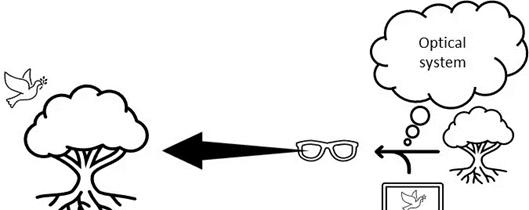On January 5, market research institute Omdia released a research report saying that optical systems are an important part of augmented reality (AR) devices. System considerations include light efficiency, ambient light transmittance, size, weight, and field of view (FOV). But there is no perfect solution yet, and different parameters must be traded off.
The report said that when designing an ar optical system, the following elements need to be considered: light efficiency, that is, the proportion of light transmitted from the projector into the human eye; ambient light transmittance; the size and weight of the optical system; the larger the better FOV (field of view). For existing common AR optical systems, they can be simply classified into two main schemes.

Optical systems in AR devices Source: Omdia
The first is to use the translucent and half-reflection characteristics of the optical element to reflect part of the display light into the human eye, and the external light can also pass through the optical device, so as to realize the combination of the image and the real world. This type of optical device can be further divided into three types: prism, free-space, and birdbath. The second type of solution is the optical waveguide type. At present, there are three main technologies: reflected optical waveguide, diffracted optical waveguide and holographic optical waveguide.
Among them, the Structure of the Prism-type optical system is the simplest, but if the FOV increases, its volume will increase dramatically. The design of the Free-space and Birdbath optical systems is more complex. Overall, the structure of the three reflective optical systems requires a larger space to implement, which creates an increase in weight and volume, limiting its application in the field of consumer electronics.
AR Optical System Schematic Source: Omdia
Omdia believes that there is no perfect AR optical solution on the market at present. Different solutions are optimized for other scenarios at the expense of specific performance. For example, Prism, an optical solution for Google Glass, was unable to solve the contradiction between narrow FOVs and large-volume optics, and was gradually abandoned by consumer electronics. However, due to its high optical efficiency, it is still used in industrial and military applications.
In addition, the advantages of Free-space and birdbath are good contrast, high resolution and large FOV, but the transmittance to ambient light is low, which is relatively more suitable for indoor scenes. Based on this, Epson's BT300 and Nreal products chose this solution.
Recently, optical waveguide solutions have been of most interest to developers due to their closer appearance to traditional glass. It has big improvements in size and viewing angle, but also has shortcomings. Among them, the reflective optical waveguide has higher optical efficiency, but also higher cost. Holographic optical waveguides may have advantages in cost, but they are not yet mature in the development of panchromatics. Currently, Akonia and Digilens are developers of such optical systems, with Akonia being acquired by Apple in 2018.
The report points out that diffracted optical waveguides are currently the most promising optical solutions in the field of AR, but their light efficiency is low. As a result, AR manufacturers have turned to high-brightness silicon-based micro LEDs (LEDoS) to solve this problem. In contrast, leDoS can be more than 1 million nits in brightness, while silicon-based OLED (OLEDoS) is only more than 10,000 nits. (Proofreading/Hidden Drei)